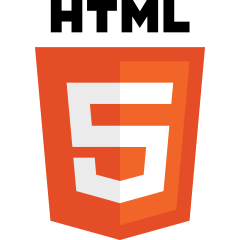web-aez-notes
Table of Contents

SVG
- Scalable Vector Graphics (SVG) is a language for vector graphics in 2D which may be interactive or include animation.
- SVG images can live in their own file or be embedded in HTML.
- There are graphics elements which form our basic objects, they are styled
with presentational attributes.
- The presentational attributes include:
strokeandstroke-width,stroke-opacityetc,fillandfill-opacity,fontand its friends.- Colours can be specified in all the standard ways.
- The presentational attributes include:
- Structural elements are ways to group together related graphics elements.
- There are transformation to alter the properties of an element.
- SVG is aware of user events and has event handlers to respond to them.
- Basic shapes:
<rect>hasxandyand awidthandheight,<circle>has acxandcyto define the centre and arfor the radius,<line>hasx1andy1, andx2andy2.
- There is a turtle-like graphics DSL which can be used with the
pathto draw more complex shapes. - There is the
<text>elements to include text. - You can use CSS to style the elements of an SVG.
HTML
Examples
Minimal example
<!DOCTYPE html>
<html>
<head>
<meta charset="UTF-8">
<title>Foobar</title>
</head>
<body>
</body>
</html>
External CSS
To apply CSS from a file add a link in the head to that file.
<link rel="stylesheet" href="mystyle.css">
Internal CSS
To have inline CSS include the following element in the <head>.
<style>
body {
background-color: linen;
}
h1 {
color: maroon;
margin-left: 40px;
}
</style>
Basics
| Tag | Use |
|---|---|
<strong> |
bold text |
<p> |
paragraph |
<img src=""> |
image |
<a href=""></a> |
link |
Linkage
- You can ask the browser to open a link in a new tab by adding
target="_blank"to anatag. There used to be a security risk in doing this, but it seems to have been resolved in the big-name browsers.
CSS Notes

Selectors
The basic ways to select are with:
type,#id,.class,- and
:pseudo-class(for example:hover)
These can be combined to refine the selection, for example p.nav or
a:visited. A comma separated list will select all the things that match at
least one selector in the list. White space between selectros is used to select
children, for example p b will select all bold descendents of a paragraph
element.
Further reading
Grid vs Flexbox
Use Flexbox if you only have a one-dimensional layout, otherwise use Grid.
Syntax
Here is a very simple example of how CSS works with HTML. First we need some HTML
<fleeb class="squanch"></fleeb> <plumbus id="hizzard"></plumbus>
then some CSS to style it:
fleeb.squanch {
key: value;
}
#hizzard {
key: value;
}
The fleeb tag uses the tag.class way to select an element to apply a style to
while the plumbus tag goes for a unique identifier. These identifiers can also
be used to hyperlink to specific parts of a page with a tags.
CSS for this website!
For the most part I have attempted to keep this website looking the same as my emacs setup. As with all aspects of this website, it is a work in progress.
- Light theme: https://aezarebski.github.io/css/stylesheet.css
- Dark theme: https://aezarebski.github.io/css/stylesheet-dark.css
Environment
You can use a .jsbeautifyrc file to configure the behaviour of web-beautify.